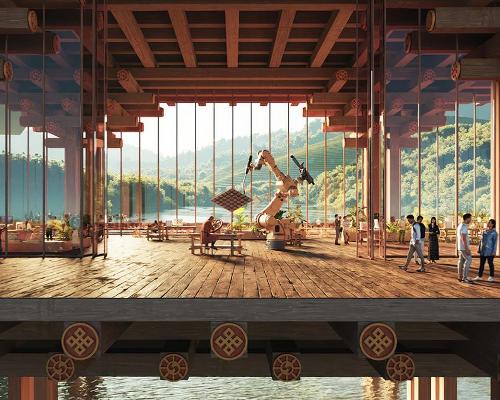Monday 06 May 2024 | Sign up for FREE magazines & ezines here
Education and career planning for the spa and wellness industry
You are here: news / industry news
You are here:
advice
Learn more >
benefits
Learn more >
stories
Learn more >
reports
Learn more >
resources
Learn more >
Spa & wellness industry news

King of Bhutan unveils ‘Mindfulness City’ masterplan for Southern Bhutan
20 Dec 2023 The King of Bhutan has announced plans to create a 1,000sq km economic hub inspired by the Bhutanese culture of respect and compassion for others and nature in Gelephu, Bhutan.Referred to as the Mindfulness City, the masterplan for the future Gelephu Special Administration Region (SAR) is informed by Bhutanese culture and its strong spiritual heritage, as well as the country's Gross National Happiness (GNH)* index.
The Buddhist country uses the GNH – focusing on the wellness of its people – as its main measure of development in addition to GDP.
The goal is for the SAR to lay the foundation for the country’s future growth and create economic opportunities for its citizens through investments in green technology, education and infrastructure. While presenting the vision during the country's 116th National Day address, King Wangchuck described the future city as an "economic corridor connecting South Asia with Southeast Asia via India’s northeastern States".
The SAR – located on the India-Bhutan border – will have legal independence and executive autonomy, plus all companies looking to do business in the region will have to be pre-approved.
The project has been designed by architecture firms Bjarke Ingels Group (BIG) and Arup and Singaporean planning city consultancy Cistri.
Designed by BIG’s Landscape and Urban Design Team, the masterplan includes a Vajrayana spiritual center, an international airport, railway connections, a hydroelectric dam, public spaces and a language for local building typologies, based on the nine domains of GNH*.
“The Gelephu masterplan gives form to His Majesty’s vision to create a city that becomes a cradle for growth and innovation while remaining founded on Bhutanese nature and culture,” said Bjarke Ingels, BIG’s founder and creative director.
Nature first
Nestled between mountains, forests and rivers, Bhutan has been labelled as one of the last biodiversity hotspots in the world, with 70 per cent of the country covered in forest.
Plans for the Mindfulness City aim to amplify the country’s biodiversity by emerging as a tapestry of interconnected ecosystems and neighbourhoods shaped by the flow of the 35 local rivers and streams.
The resulting ribbonlike neighbourhoods will resemble paddy fields, forming urban terraces that cascade down from the hills to the valley.
The city will increase in density from the rural and recreational highlands to the urban and dense lowlands.
“We imagine the Mindfulness City as a place that could be nowhere else,” Ingles added, “where nature is enhanced, agriculture is integrated and tradition is living and breathing, not only preserved but also evolved.
“Shaped by waterways, Gelephu becomes a land of bridges, connecting nature and people, past and future, local and global.”
Ingles says the natural elements and the existing infrastructure, agriculture and utilities of Gelephu naturally create 11 distinct neighbourhoods across the area.
Each has been designed based on the principles of the Mandala: defined by a series of repeating typologies organised symmetrically around a central public space, a gradual transition in density is created, from small buildings dispersed in the landscape in the north to larger footprints within an urban environment in the south.
To protect existing and future development against flooding in the monsoon season, paddy fields will be established along the site’s rivers and tributaries, running from north to south.
These will further function as biodiversity corridors for local flora and fauna, leaving the migratory routes of elephants and other wildlife undisturbed.
Giulia Frittoli, partner in charge, BIG Landscape, added: “Inspired by the Bhutanese culture of respect and compassion for others and nature, the Mindfulness City is designed to enhance ecological systems, through an urban development that connects flora and fauna, as well as people and ideas.
“It's become a testament to humanity's inseparable bond with nature and a global example of how to build a sustainable human presence on Earth.”
Bridging the gap
The neighbourhoods within the city, which will be divided by rivers, will be tied together by three main bridges.
Occasionally, these will double as transportation infrastructure combined with civic and cultural facilities, creating a series of ‘inhabitable bridges’ which are tailored to the nine NGH* domains.
Each one will house key destinations within the city: an airport, a spiritual center which will allow glimpses into monks’ daily practices; a healthcare center as a meeting between Eastern and Western medicine; a university; a hydroponic and aquaponic greenhouse; a cultural center to immerse and educate visitors about Bhutanese culture; and a market adorned with Bhutanese textiles.
The final bridge, a hydroelectric dam, will be constructed on the city’s western border with a step-well retaining wall that offers viewpoints, staircases for meditative walks and a temple.
*Bhutan’s GNH – The GNH is based on nine areas; Psychological Wellbeing, Health, Education, Living Standards, Time-Use, Ecological Diversity and Resilience, Good Governance, Cultural Diversity and Resilience, and Community Vitality.
More industry news
Further news sources
Get your weekly ezines and FREE digital magazines – sign up here
Get the latest spa news, career opportunities and FREE digital magazines from Spa Business and Spa Business insider
© Cybertrek 2024

